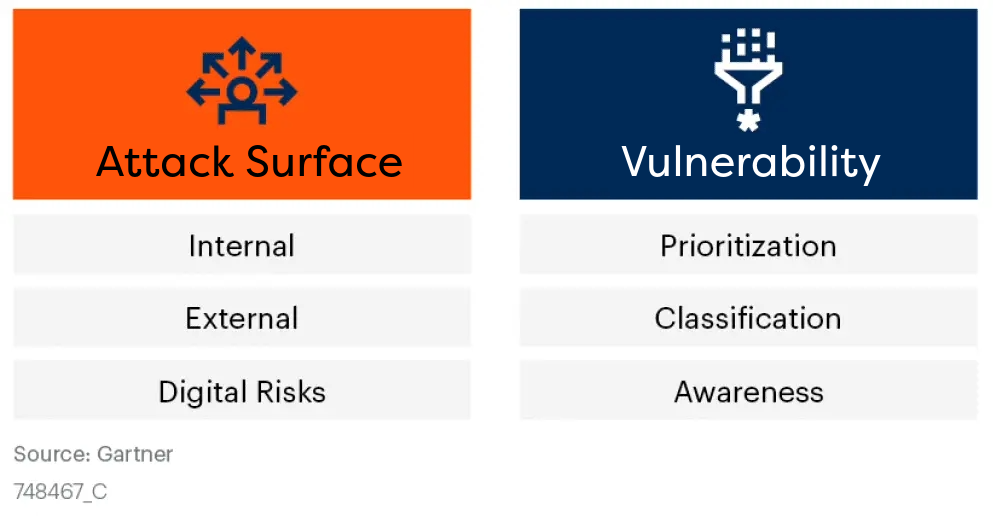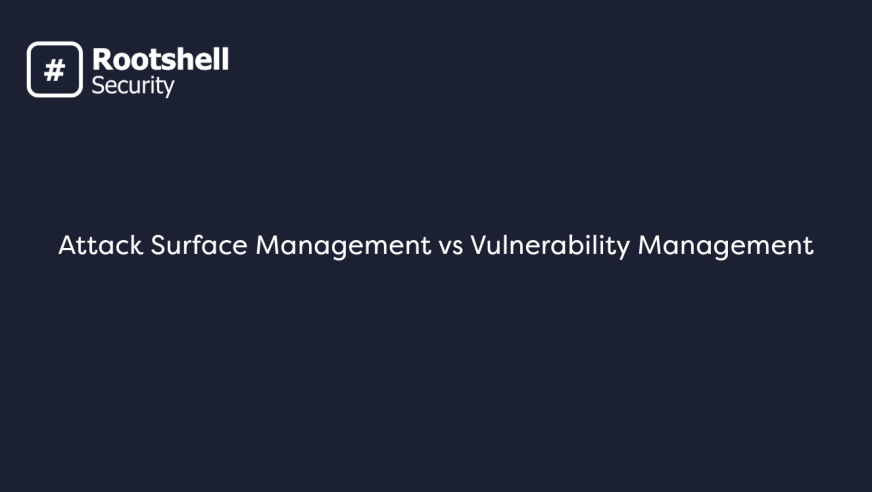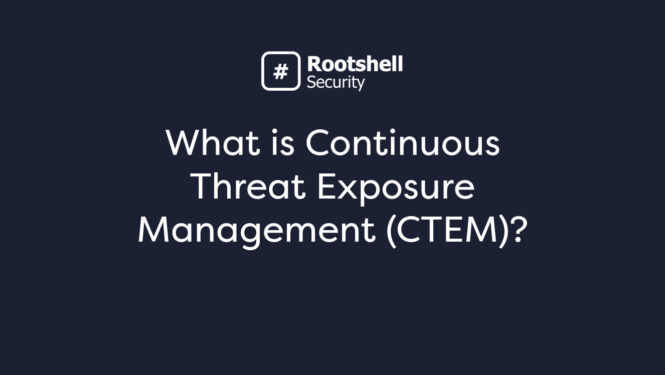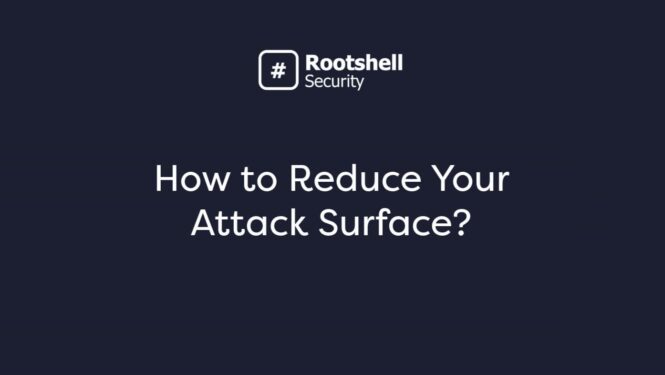The Difference Between Attack Surface Management (ASM) and Vulnerability Management (VM)
Cybersecurity is a dynamic field that constantly evolves with the emergence of new threats and vulnerabilities. Within this realm, two crucial processes stand out: Attack Surface Management (ASM) and Vulnerability Management (VM). Although intertwined, they serve distinct purposes and are fundamental for a well-rounded security posture. In this blog, we will be exploring attack surface management vs vulnerability management or attack surface reduction vs vulnerability management.
The primary distinction between the two lies in their respective areas of security emphasis within an organizational framework. ASM possesses a more expansive perspective, whereas vulnerability management has a more confined focus, zeroing in on the direct repercussions of a compromised asset.
Within this topic, VM serves as a specialized component. Its emphasis is more niche, revolving around scanning for code vulnerabilities and adopting precise measures for remediation. Its main task is to detect, categorize, prioritize, and address vulnerabilities in systems or networks that are susceptible to breaches.
On the other hand, attack surface management leans more toward an infrastructural perspective, granting IT departments a comprehensive understanding of their external assets and the cybersecurity challenges they face. ASM discerns the interconnections between devices, networks, and software, and is concerned with safeguarding potential breach points (or attack vectors) spanning an organization’s systems, applications, IoT gadgets, data, and more, which go beyond mere security flaws.
While each is proficient in its dedicated domain, neither should be viewed as a substitute for the other. Rather, their integration fortifies an organization’s cyber protection mechanisms. Together, they craft a meticulously structured cybersecurity blueprint, providing in-depth insights into an organization’s IT security stature.

What is Attack Surface Management?
What is an Attack Surface?
The internal attack surface encompasses all the potential vulnerabilities within an organization’s internal network, systems and infrastructure. This includes everything inside the organization’s perimeter defences, such as firewalls and intrusion prevention systems. The internal attack surface takes into account threats that may come from within the organization, such as employees, contractors, and other personnel who have access to the network and systems. It also considers potential security gaps or vulnerabilities in the organization’s IT environment that could be exploited by insiders or attackers who manage to breach the perimeter defences.
Examples of this include:
- Employee devices and workstations,
- Internal servers and applications,
- Databases and data storage,
- Network devices and routers,
- Access controls and authentication mechanisms,
- Physical security measures within the organization’s premises,
Protecting against internal threats involves implementing strong access controls, monitoring unusual activities, educating employees about security best practices, and maintaining proper separation of duties.
The external attack surface encompasses all the potential vulnerabilities and entry points that are accessible from outside the organization’s network. It includes the points at which the organization’s systems and services interact with external entities, such as the Internet, third-party services and remote users. External attackers target these entry points to gain unauthorized access or exploit vulnerabilities. Learn more about external attack surface management.
Examples of this component include:
- Internet-facing servers and applications,
- Publicly accessible APIs (Application Programming Interfaces),
- Domain names and DNS (Domain Name System) infrastructure,
- Email servers and communication channels,
- Remote access mechanisms like VPN (Virtual Private Network),
- Web applications accessible to the public.
Protecting against external threats involves implementing strong perimeter defences, such as firewalls, intrusion detection/prevention systems and web application firewalls. Regular vulnerability assessments, penetration testing and security monitoring are also important for identifying and addressing potential vulnerabilities in the external attack surface.
How Does Attack Surface Management Work?
- Continuously discovering external digital assets across the entire internet, ensuring no asset remains unknown or forgotten.
- Classifying these assets based on their importance and potential risk.
- Identifying potential vulnerabilities or misconfigurations in these assets that could be exploited.
- Providing security groups with actionable insights to secure these assets before they can be exploited.
With digital transformations accelerating, ASM is no longer a luxury but a necessity. It ensures that an organization is always aware of its expanding attack surface and is taking necessary actions to minimize risks associated with it.
Benefits of Attack Surface Management:
- Comprehensive Visibility: ASM provides organizations with a complete view of their digital footprint, encompassing all external assets — whether known or unknown. This ensures that no critical asset remains unmonitored or unprotected.
- Early Threat Detection: By continually monitoring the external attack surface, ASM helps detect potential threats and vulnerabilities early, allowing organizations to take proactive measures before they are exploited.
- Reduction of Cyber Exposure: ASM aids in identifying and minimizing the areas vulnerable to attacks, thereby decreasing the overall likelihood of a breach or security incident.
- Enhanced Incident Response: With a real-time view of the attack surface, security teams can prioritize and respond to incidents more efficiently, ensuring faster remediation of vulnerabilities.
- Comprehensive Asset Management: ASM solutions can automatically identify, categorize, and track external assets, facilitating better management and ensuring that security protocols are consistently applied across all assets.
- Better Integration with Vulnerability Management: ASM complements vulnerability management by providing a broader context, helping security teams prioritize which vulnerabilities to tackle based on their potential exposure and impact.
- Improved Regulatory Compliance: By identifying and rectifying vulnerabilities, organizations can better comply with industry regulations and standards, avoiding penalties and enhancing their reputation.
- Continuous Monitoring: ASM offers continuous and automated monitoring of the attack surface, ensuring that new assets or potential vulnerabilities are quickly identified and addressed.
- Cloud Security Enhancement: With the growing adoption of cloud services, ASM ensures that cloud assets are also securely configured and monitored, addressing issues like misconfigured cloud storage or unauthorized cloud services.
- Increased Confidence and Trust: Having a robust ASM in place bolsters the confidence of stakeholders, clients, and partners, as they can trust the organization to safeguard its digital assets effectively.
- Holistic Security Strategy: By encompassing the entirety of an organization’s digital exposure, ASM promotes a holistic security strategy that is both comprehensive and aligned with business objectives.
- Budget Optimization: By providing visibility into the most critical assets and vulnerabilities, ASM allows organizations to allocate their security budgets more effectively, focusing on areas of highest risk.
In conclusion, Attack Surface Management (ASM) is not just a security tool, but a strategic approach that empowers organizations to navigate the complex digital landscape with better visibility, agility, and resilience. It’s a crucial component for any forward-thinking organization that aims to stay one step ahead of potential cyber threats.
What is Vulnerability Management
What is a Vulnerability?
A vulnerability can be thought of as a weakness or flaw in a system, application, or process. It’s the chink in the armour that attackers aim to exploit. Vulnerabilities can emerge from misconfigurations, software bugs, or even outdated systems. Their scope can range from benign issues to critical flaws that can compromise sensitive data.
How Does Vulnerability Management Work?
Vulnerability management is a proactive approach to identifying, assessing, prioritizing, and remediating security vulnerabilities within an organization’s systems, applications, and network infrastructure. This process aims to minimize the attack surface and reduce the risk of cyber threats in the context of risk management.
At its core, it involves the continuous vulnerability monitoring of the IT environment to identify new vulnerabilities and assess existing ones. Security teams use specialized tools, known as vulnerability scanners, to conduct regular vulnerability scans. These scans are designed to discover software vulnerabilities and other weaknesses that could be exploited by malicious actors.
Gartner “Vulnerability management remains a critical security operations activity that helps organizations identify assets, mitigate threats and meet compliance mandates.” (Marketing Guide for Vulnerability Assessment, August 2023)
Here’s how it typically works:
- Discovery: Utilizing scanners, tools, and threat intelligence feeds, vulnerabilities are identified within systems, applications, and networks.
- Prioritization: Once identified, vulnerabilities are ranked based on factors like exploitability, potential impact, asset value, and the CVSS (Common Vulnerability Scoring System) score.
- Remediation: After prioritization, vulnerabilities are addressed. This might involve patching software, altering configurations, or even decommissioning systems.
- Verification: Once remediation steps are taken, the system is retested to ensure vulnerabilities are genuinely addressed.
While VM does focus on vulnerabilities, its holistic aim is to minimize the window of opportunity for attackers by ensuring that these weaknesses are identified and addressed promptly.
Vulnerability Management vs Attack Surface
While both ASM and Vulnerability Management aim to bolster security, their approaches differ:
- Focus: ASM emphasizes understanding and managing the entire attack surface. Vulnerability Management zeroes in on individual vulnerabilities.
- Scope: ASM offers a broad overview of potential risks across the organization, while Vulnerability Management delves into specifics.
- Methodology: ASM often employs machine learning and predictive analytics, whereas Vulnerability Management systems frequently uses scanners and other specific detection tools.
How Do Attack Surface Management and Vulnerability Management Work Together?
When synchronized, ASM and Vulnerability Management create a formidable defense strategy. ASM identifies the potential attack vectors, allowing security teams to have a broader view of threats. Once identified, Vulnerability Management takes over to patch these vulnerabilities, ensuring an organization’s assets are shielded from threats.
The synergy between ASM and Vulnerability Management ensures continuous attack surface monitoring and prompt vulnerability remediation, safeguarding assets from evolving cyber threats.
Attack Surface Management and Vulnerability Management Challenges
While both processes are vital, they come with their challenges:
- Expanding Digital Footprints: As organizations embrace digital transformation, the attack surface continuously grows with the integration of new technologies, IoT devices, cloud platforms, and third-party applications. Keeping track of and securing this ever-expanding attack surface is a significant challenge.
- Dynamic Nature of Assets: Assets in the digital landscape aren’t static. They can change or move, with new assets being added and old ones retired. Ensuring continuous visibility and protection of these dynamic assets can be tricky for security teams.
- Fragmented Toolsets: Many organizations deploy a myriad of security tools for different tasks, leading to fragmented visibility and gaps in their defense mechanisms. This disparate approach can make cohesive attack surface management and vulnerability management more challenging.
- Advanced and Evolving Threats: Cybersecurity threats evolve at a rapid pace. Adversaries are continuously devising new attack vectors and techniques, requiring organizations to stay vigilant and update their defense mechanisms regularly.
- Limited Resources: Despite the growing number of threats, many organizations face resource constraints, with security teams often stretched thin, trying to manage a vast number of alerts and incidents.
- Patch Management Delays: Even when vulnerabilities are detected, delays in patch management can leave organizations exposed for extended periods. Ensuring timely patching and remediation across all assets can be a logistical nightmare.
- False Positives: Security tools can sometimes generate false positives, leading security teams to spend valuable time chasing down issues that aren’t genuine threats, thereby diverting attention from real vulnerabilities.
- Lack of Context: Without context regarding how critical a specific asset or vulnerability is, prioritizing remediation efforts can be difficult. Organizations need a risk-based approach to manage threats effectively.
- Compliance Pressures: Meeting industry regulations and standards adds another layer of complexity to ASM and vulnerability management. Non-compliance can result in hefty penalties, adding financial implications to the security challenges.
- Siloed Departments: Many organizations operate in silos, with limited communication between IT, operations, and security groups. This lack of coordination can hinder cohesive attack surface and vulnerability management efforts.
- Cloud Configuration Issues: As more businesses migrate to the cloud, misconfigurations can expose them to threats. Proper attack surface management must extend to cloud assets, ensuring they are securely configured and monitored.
- Over-reliance on Traditional Methods: Traditional pentesting, while valuable, might not provide continuous visibility into vulnerabilities. Organizations need modern, continuous monitoring solutions to complement these methods.
Best Practices For Implementing Attack Surface Management and Vulnerability Management
- Adopt a Zero Trust Model: Assume everything is a potential threat. Implementing a zero-trust framework ensures stringent access controls and rigorous authentication processes.
- Continuous Monitoring: Don’t wait for monthly or quarterly assessments. The digital landscape is fluid, and continuous monitoring is vital.
- Prioritize Risks: Use a risk-based approach to address the most pressing vulnerabilities first.
- Educate Your Team: The human element remains a significant vulnerability. Regular training ensures your team is updated on the latest threats and best practices.
- Leverage Advanced Tools: Embrace machine learning and AI-driven tools for improved accuracy and prediction capabilities.
Attack Surface Management with Rootshell Security
Rootshell Security is the ideal partner for clients seeking comprehensive Attack Surface Management (ASM) assessments. We couple the power of the Rootshell’s Platform and the pedigree of the Security Consultants we employ.
We have provided the key points of expertise to Rootshell’s approach to ASM:
- Expertise and Experience: Rootshell Security boasts a team of highly skilled and experienced cybersecurity professionals. Our expertise covers a wide range of industries, technologies, and threat landscapes, ensuring that clients receive assessments tailored to their specific needs.
- Cutting-Edge Technology: Rootshell Security is empowered by our platform which also employs state-of-the-art tools and technologies to perform ASM assessments. By continuously updating our tool sets to stay ahead of emerging threats and vulnerabilities, we provide clients with accurate and up-to-date insights into their attack surface.
- Comprehensive Coverage: Rootshell Security takes a holistic approach to ASM assessments, considering all potential attack vectors, from network and application vulnerabilities to social engineering risks. This comprehensive coverage ensures that clients gain a thorough understanding of their security posture.
- Customized Solutions: Rootshell Security recognizes that every organization is unique. We tailor the ASM assessments to align with a client’s specific business objectives, compliance requirements, and risk tolerance, providing actionable recommendations that are practical and relevant.
- Proactive Risk Mitigation: Beyond identifying vulnerabilities, Rootshell focuses on helping clients mitigate risks effectively. We provide actionable insights and prioritize vulnerabilities based on their potential impact and exploitability, enabling clients to address the most critical issues promptly.
- Reporting and Communication: Rootshell Security delivers clear and concise reports that facilitate easy understanding of assessment findings. Our team communicates findings and recommendations in a way that empowers clients to make informed decisions and take proactive steps to enhance their security posture.
- Compliance and Regulations: Rootshell Security is well-versed in industry-specific regulations and compliance requirements. Clients can rely on our expertise to ensure that the ASM assessments align with applicable standards, helping to meet regulatory obligations.
- Continuous Monitoring: ASM is an ongoing process, and Rootshell along with Rootshell’s Platform, offers continuous monitoring services to help clients stay ahead of evolving threats. Our proactive approach helps organizations maintain robust security in the face of ever-changing cybersecurity landscapes.
- Cost-Effective Solutions: Rootshell Security understands the importance of budget constraints. We offer cost-effective ASM assessment services without compromising on quality, making cybersecurity accessible to organizations of all sizes.
- Reputation and Trust: Rootshell Security has earned a strong reputation in the cybersecurity industry for delivering high-quality ASM assessments. Clients can trust our expertise and commitment to securing digital assets effectively.
In conclusion, clients should choose Rootshell Security for their Attack Surface Management assessments because of our deep expertise, cutting-edge technology, comprehensive approach, customization, and commitment to helping organizations proactively manage and mitigate security risks.
Don’t let your organization be blindsided by unseen vulnerabilities or expansive attack surfaces. Reach out to our team of cybersecurity experts at Rootshell Security today, and fortify your defenses against the ever-evolving cyber threat landscape.



